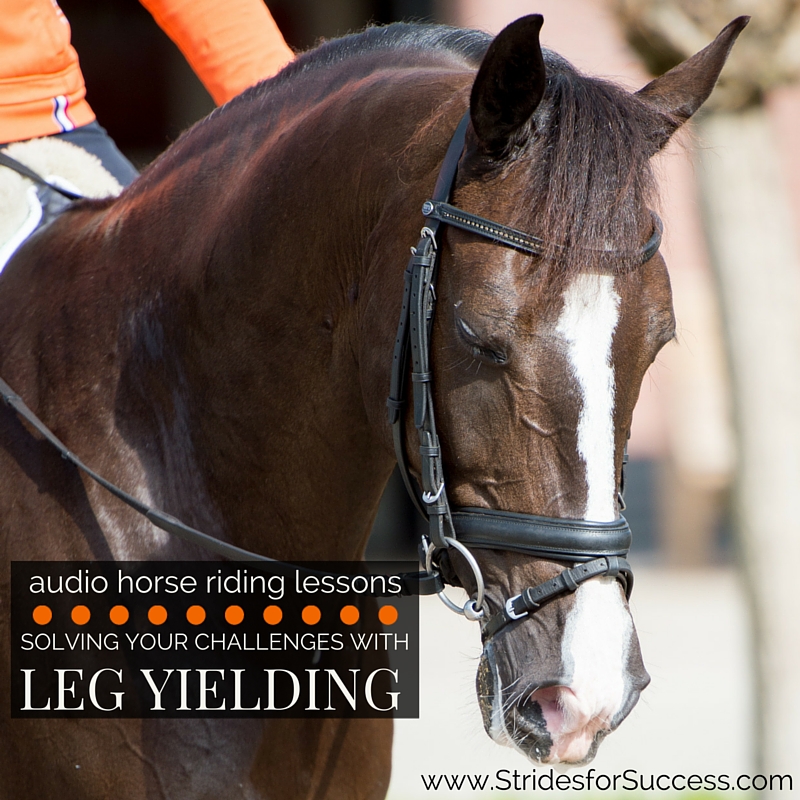Leg yielding is generally most riders’ first introduction to lateral movement. Lateral moving, when we’re talking horses, means sideways. It is a great movement to ride as it allows you to work your horse’s body in a different, yet equally beneficial way.
Leg yielding, and lateral movements in general, are a test of our abilities as riders to move each individual limb independently at the same time.
Think of it like this; each part has it’s own equally important job which when applied together, give your horse the directions and support he needs to perform the movement.

Become Clear on What You Want…
To ask your horse to leg yield, you must first become clear in your mind as to what you want your horse to do and where you want him to do it.
With regards to the ‘where’, I suggest coming in from the outside track to perhaps the quarter line. This is the line halfway between the center line and the outside track on the long side of the arena.
This way you are using your horses natural tendency to want to return to the outside track to your favor.
Setting up the Movement
The next part is setting the movement up. Your horse needs to be straight, meaning that his hips are following directly behind his shoulders. This will remain a key part of correctly performing the leg yield.
Ask for a slight flexion in the poll area (perhaps where you can just see the inside eyelid) but his body should remain straight.
The final part of setting up the movement is the all-important half halt. It will help to balance things, but also give your horse the heads up and that you are about to ask for something different. Don’t limit your half-halt to just one. In fact, usually, 3 or 4 or more will be necessary to give you the desired results.
Make sure you keep your leg on throughout the half halt.
Asking your horse to yield to your leg
So the word ‘Yield’ means to give way to, in this case, pressure. You must create pressure with your inside leg. This is the leg your horse must move away from. Where you place your leg to ask will depend on your horse’s level of training.
Younger or greener horses will require your lower leg to be slightly behind the girth, as they will often have the tendency to move over with their shoulders and leave their hindquarters trailing or following behind.
Remember, in order to perform the movement correctly, your horse’s hips and shoulders must remain straight… Not one trailing diagonally across the arena after the other.
Your outside leg will help to maintain consistent impulsion and also act as a ‘blocker’ should either your horse’s hips or shoulders get ahead of the other. Your outside leg will also help to ‘end’ the leg yielding movement when you have reached your desired destination and asking your horse to go straight forward again.
Asking for Flexion
Begin with flexion. Use your inside hand to ask for the slight flexion in your horse’s poll area. This must remain soft and all the while aware that you’re not asking for too much bend.
Your outside hand, as always, holds everything together. It also helps to prevent too much bend in the head and neck of your horse.
Also, your outside hand can also be ‘opened’ slightly away from your horse’s neck which may encourage your horse to move over into the rein.
Remain Light and Soft…
One of the biggest mistakes I see riders doing when first attempting this movement is an over-enthusiastic ‘shoving’ movement with their hips and seat… This will not help! In fact, sitting tall and quietly is vital to your horse being able to move in this manner.
Your ‘pushing’ motion with your hips will only unbalance your horse and cause him to be unable to successfully yield to your leg.
I have written (and recorded Daily Strides Podcast Episodes) in far more detail on this topic HERE and HERE. I will also link to more resources to help with this below.
Happy Riding
Lorna
